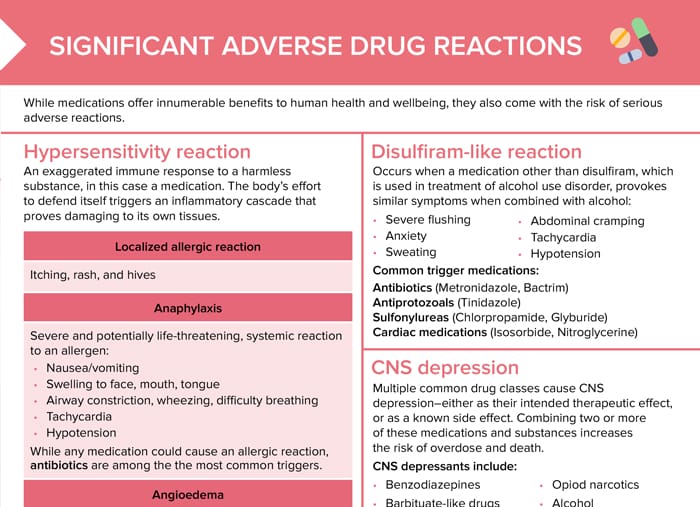What are adverse drug reactions?
Adverse drug reactions are unwanted or harmful effects experienced following the administration of a drug or combination of drugs under normal usage conditions. They can occur with any medication and range from mild (e.g., headache, rash) to severe (e.g., anaphylaxis).
Adverse drug reaction types
Adverse reactions can be allergic reactions, side effects, overdoses, and interactions with other drugs, food, or diseases. Identifying, managing, and reporting adverse drug reactions are essential nursing responsibilities. Significant types of severe adverse reactions include hypersensitivity reactions, disulfiram-like reactions, and CNS depression.
What is a hypersensitivity drug reaction?
A hypersensitivity reaction is an exaggerated immune response to a harmless substance, in this case a medication. The body’s effort to defend itself triggers an inflammatory cascade that proves damaging to its own tissues.
Localized allergic reaction
Localized allergic reactions present with itching, rash, and hives.
Anaphylaxis
Anaphylaxis is a severe and potentially life-threatening systemic reaction to an allergen. Symptoms include:
- Nausea/vomiting
- Swelling to face, mouth, tongue
- Airway constriction, wheezing, difficulty breathing
- Tachycardia
- Hypotension
While any medication could cause an allergic reaction, antibiotics are among the most common triggers.
Angioedema
Angioedema is an allergic reaction causing swelling in deep layers of skin and other tissues. It often affects lips, mouth, tongue and may compromise the airway.
Common trigger medications include ACE inhibitor and angiotensin receptor blocker blood pressure medications.
Red man syndrome
Red man syndrome is a severe reaction to the antibiotic vancomycin.
Symptoms:
- Flushing
- Rash
- Severe itching
- Tachycardia
- Hypotension
Preventive measures include infusing slowly and pre-medicating with antihistamine.
What are disulfiram-like reactions?
A disulfiram-like reaction occurs when a medication other than disulfiram, which is used in treatment of alcohol use disorder, provokes similar symptoms when combined with alcohol.
Symptoms:
- Severe flushing
- Anxiety
- Sweating
- Abdominal cramping
- Tachycardia
- Hypotension
Common trigger medications include:
- Antibiotics (Metronidazole, Bactrim)
- Antiprotozoals (Tinidazole)
- Sulfonylureas (Chlorpropamide, Glyburide)
- Cardiac medications (Isosorbide, Nitroglycerine)
CNS depression as an adverse effect
Multiple common drug classes cause CNS depression, either as the intended therapeutic effect, or as a known adverse effect. Combining two or more of these medications and substances increases the risk of overdose and death.
Known CNS depressants:
- Benzodiazepines
- Barbiturate-like drugs
- Antihistamines
- Opioid narcotics
- Alcohol
Symptoms of CNS depression/overdose:
- Altered mental status
- Reduced respiratory rate
- Cold, clammy skin
- Lethargy
- Bradycardia
- Cyanosis

